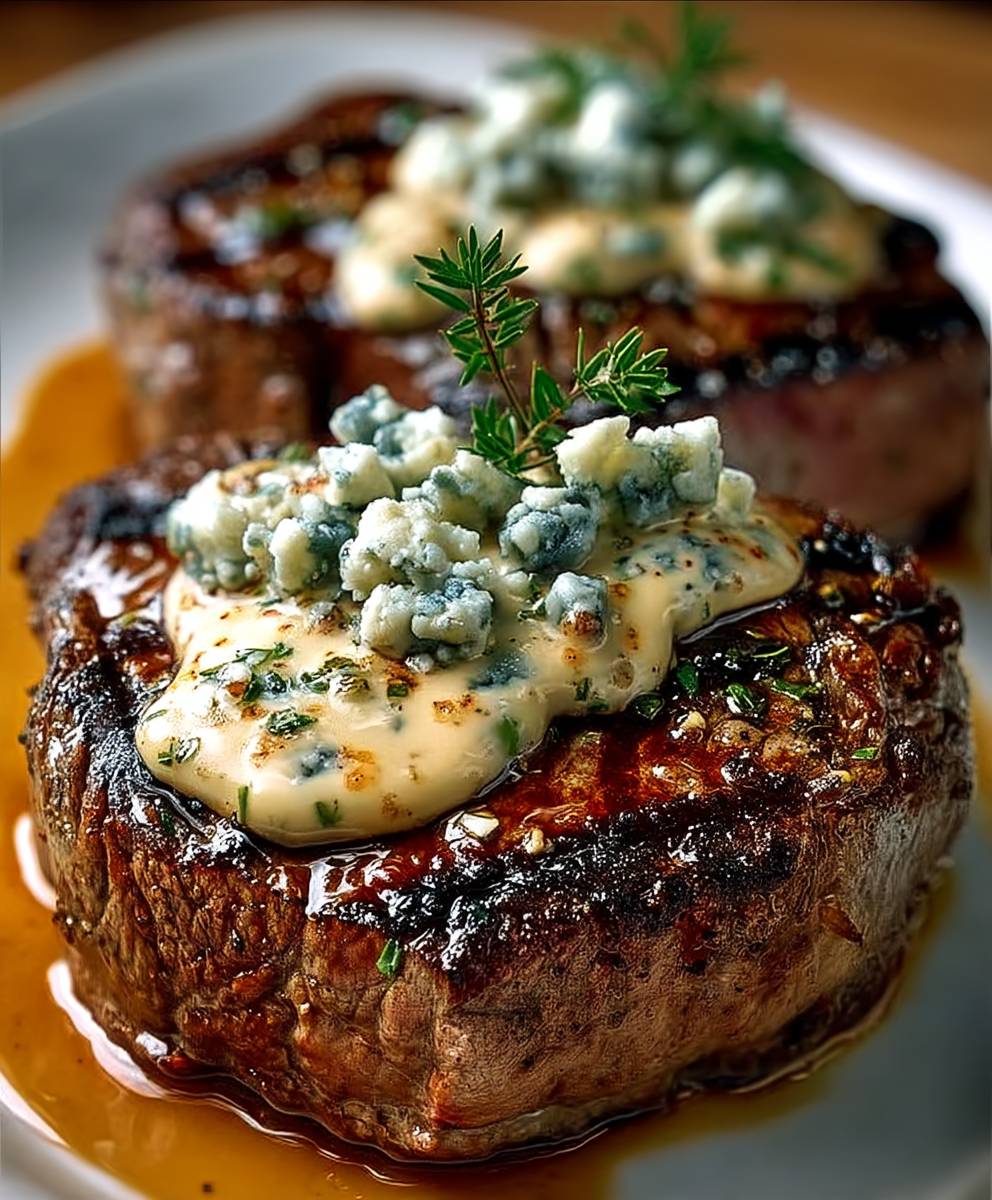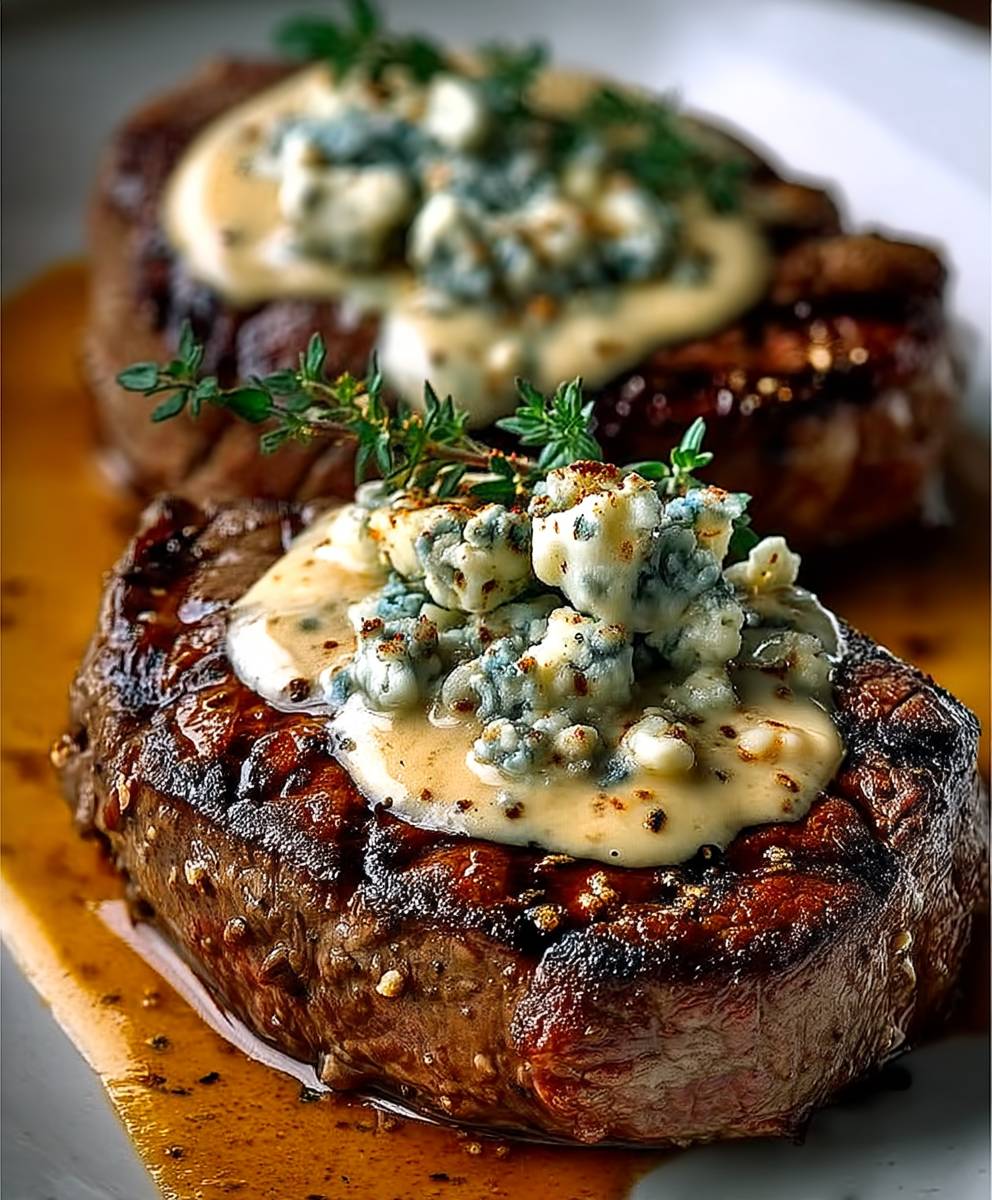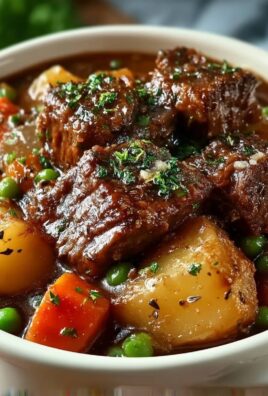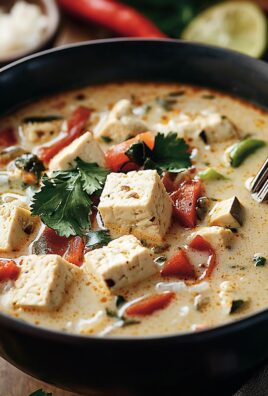Ribeye Steaks Blue Cheese, a culinary masterpiece that elevates the classic steak dinner to an unforgettable experience! Have you ever craved a dish that’s both incredibly rich and surprisingly easy to prepare? This is it. Imagine sinking your teeth into a perfectly seared ribeye, its juicy tenderness enhanced by the pungent, creamy tang of melted blue cheese. It’s a symphony of flavors that will leave you wanting more.
While the exact origins of pairing blue cheese with steak are somewhat shrouded in culinary history, the combination has become a staple in upscale steakhouses and home kitchens alike. The boldness of the blue cheese cuts through the richness of the ribeye, creating a balanced and sophisticated flavor profile. It’s a testament to the power of contrasting tastes working in perfect harmony.
People adore this dish for several reasons. First, the taste is simply divine the savory steak, the salty blue cheese, and the potential hint of garlic or herbs create an explosion of flavor. Second, the texture is incredible, from the crisp sear on the steak to the smooth, melting cheese. Finally, while it feels luxurious, preparing Ribeye Steaks Blue Cheese is surprisingly straightforward, making it perfect for a special occasion or a well-deserved weeknight treat. I’m excited to share my foolproof method for achieving steakhouse-quality results in your own kitchen!
Ingredients:
- 2 (12-16 ounce) Ribeye Steaks, about 1.5 inches thick
- 2 tablespoons Olive Oil
- 1 tablespoon Butter
- 1 large Shallot, finely minced
- 2 cloves Garlic, minced
- 1/4 cup Dry Red Wine (such as Cabernet Sauvignon or Merlot)
- 1/2 cup Beef Broth
- 4 ounces Blue Cheese, crumbled (high-quality, such as Roquefort or Gorgonzola)
- 2 tablespoons Heavy Cream
- 1 tablespoon Fresh Parsley, chopped
- Salt and freshly ground Black Pepper, to taste
- Optional: Fresh Thyme sprigs, for garnish
Preparing the Steaks:
- Bring the steaks to room temperature. This is crucial for even cooking. Take the steaks out of the refrigerator about 30-45 minutes before you plan to cook them. This allows the internal temperature to rise slightly, resulting in a more evenly cooked steak.
- Pat the steaks dry with paper towels. Removing excess moisture is essential for achieving a good sear. A dry surface will brown much better than a wet one.
- Season generously with salt and pepper. Don’t be shy! Seasoning is key to a flavorful steak. Use a generous amount of kosher salt and freshly ground black pepper on both sides of the steaks. The salt will help to draw out moisture and create a beautiful crust.
Cooking the Steaks:
- Heat the olive oil in a heavy-bottomed skillet over high heat. Cast iron is ideal for this, as it retains heat very well. Make sure the skillet is screaming hot before adding the steaks. You should see a shimmer in the oil and it should almost be smoking.
- Sear the steaks. Carefully place the steaks in the hot skillet, ensuring they aren’t overcrowded. Sear for 3-4 minutes per side for medium-rare, or longer for your desired level of doneness. Avoid moving the steaks around while they are searing, as this will prevent them from developing a good crust. You want a deep, rich brown color.
- Add butter and aromatics. Once the steaks are seared on both sides, add the butter to the skillet. As the butter melts, tilt the skillet and use a spoon to baste the steaks with the melted butter. This adds flavor and helps to keep the steaks moist. Add the minced shallot and garlic to the skillet and cook for about 30 seconds, or until fragrant. Be careful not to burn the garlic.
- Continue cooking to desired doneness. Use a meat thermometer to check the internal temperature of the steaks. For medium-rare, aim for 130-135°F (54-57°C). For medium, aim for 135-145°F (57-63°C). For medium-well, aim for 145-155°F (63-68°C). For well-done, aim for 155°F (68°C) and above. Remember that the steaks will continue to cook slightly after you remove them from the heat.
- Remove the steaks from the skillet and let them rest. Transfer the steaks to a cutting board and tent them loosely with foil. Let them rest for at least 10 minutes before slicing. This allows the juices to redistribute throughout the steak, resulting in a more tender and flavorful final product.
Making the Blue Cheese Sauce:
- Deglaze the skillet. After removing the steaks, pour the red wine into the same skillet. Bring to a simmer over medium heat, scraping up any browned bits from the bottom of the pan. These browned bits, called fond, are packed with flavor and will add depth to the sauce.
- Reduce the wine. Let the wine simmer for about 2-3 minutes, or until it has reduced by about half. This will concentrate the flavor and remove some of the alcohol.
- Add beef broth. Pour in the beef broth and bring to a simmer. Continue to simmer for another 2-3 minutes, or until the sauce has slightly thickened.
- Stir in the blue cheese and heavy cream. Reduce the heat to low and stir in the crumbled blue cheese and heavy cream. Cook until the blue cheese is melted and the sauce is smooth and creamy. Be careful not to boil the sauce, as this can cause the cheese to separate.
- Season to taste. Season the sauce with salt and pepper to taste. Keep in mind that blue cheese is already quite salty, so you may not need to add much salt.
- Stir in the parsley. Stir in the chopped fresh parsley just before serving.
Serving:
- Slice the steaks against the grain. This will make them more tender and easier to chew.
- Spoon the blue cheese sauce over the sliced steaks. Be generous with the sauce!
- Garnish with fresh thyme sprigs, if desired. This adds a touch of elegance to the presentation.
- Serve immediately. Enjoy your delicious ribeye steaks with blue cheese sauce!
Tips for the Perfect Ribeye:
- Choose high-quality steaks. The quality of the steak will greatly impact the final result. Look for steaks that are well-marbled, meaning they have streaks of fat running throughout the meat. This fat will render during cooking, adding flavor and moisture.
- Don’t overcook the steaks. Ribeye steaks are best served medium-rare or medium. Overcooking will make them tough and dry.
- Use a meat thermometer. A meat thermometer is the best way to ensure that your steaks are cooked to the desired level of doneness.
- Let the steaks rest. Resting the steaks is crucial for allowing the juices to redistribute, resulting in a more tender and flavorful steak.
- Don’t be afraid to experiment with the sauce. You can add other ingredients to the blue cheese sauce, such as mushrooms, onions, or garlic.
Variations:
- Gorgonzola Sauce: Substitute Gorgonzola cheese for the Roquefort for a slightly milder flavor.
- Mushroom Blue Cheese Sauce: Sauté sliced mushrooms in the skillet after searing the steaks, before deglazing with wine.
- Spicy Blue Cheese Sauce: Add a pinch of red pepper flakes to the sauce for a touch of heat.
- Creamy Horseradish Sauce: For a different flavor profile, try a creamy horseradish sauce instead of blue cheese. Combine horseradish, sour cream, mayonnaise, and a touch of lemon juice.
Serving Suggestions:
- Roasted Vegetables: Asparagus, Brussels sprouts, or potatoes are all great choices.
- Mashed Potatoes: Creamy mashed potatoes are a classic accompaniment to steak.
- Salad: A simple green salad with a vinaigrette dressing will provide a refreshing contrast to the richness of the steak.
- Garlic Bread: Crusty garlic bread is perfect for soaking up the delicious blue cheese sauce.
Wine Pairing:
- Cabernet Sauvignon: A full-bodied Cabernet Sauvignon is a classic pairing for ribeye steak.
- Merlot: A Merlot is another good option, especially if you prefer a slightly softer wine.
- Zinfandel: A Zinfandel can also pair well with ribeye, especially if the steak is cooked with a spicy rub.
Storage:
- Leftover Steak: Store leftover steak in an airtight container in the refrigerator for up to 3 days.
- Leftover Sauce: Store leftover blue cheese sauce in an airtight container in the refrigerator for up to 2 days.
Reheating:
- Steak: Reheat steak gently in a skillet over low heat or in a preheated oven at 300°F (150°C). Avoid overcooking the steak when reheating.
- Sauce: Reheat the blue cheese sauce in a saucepan over low heat, stirring occasionally. Add a splash of milk or cream if the sauce becomes too thick.

Conclusion:
And there you have it! This Ribeye Steaks with Blue Cheese recipe isn’t just another steak dinner; it’s an experience. The perfectly seared ribeye, with its rich marbling and melt-in-your-mouth texture, combined with the tangy, creamy punch of blue cheese, creates a symphony of flavors that will tantalize your taste buds. It’s a dish that’s both elegant enough for a special occasion and simple enough for a satisfying weeknight meal. I truly believe this will become a staple in your cooking repertoire.
Why is this a must-try? Because it elevates the classic steak dinner to a whole new level. The blue cheese not only adds a unique flavor profile but also melts beautifully into the steak, creating a luscious sauce that you won’t find anywhere else. Forget bland, boring steaks this recipe is all about bold flavors and unforgettable textures. Plus, it’s surprisingly easy to make. You don’t need to be a professional chef to achieve restaurant-quality results. With just a few simple steps and readily available ingredients, you can create a culinary masterpiece in your own kitchen.
But the best part? It’s incredibly versatile! Feel free to experiment with different types of blue cheese. Roquefort will give you a sharper, more intense flavor, while Gorgonzola is milder and creamier. You could even try adding a sprinkle of toasted walnuts or pecans for a bit of crunch and nutty flavor.
Serving Suggestions and Variations:
* Classic Pairing: Serve your Ribeye Steaks with Blue Cheese alongside roasted asparagus and garlic mashed potatoes for a complete and satisfying meal.
* Wine Pairing: A bold Cabernet Sauvignon or a rich Merlot will complement the flavors of the steak and blue cheese perfectly.
* Salad Sensation: For a lighter meal, serve the steak with a fresh arugula salad tossed with a lemon vinaigrette. The peppery arugula will cut through the richness of the steak and cheese.
* Blue Cheese Butter: For an even more decadent experience, create a blue cheese butter by combining softened butter with crumbled blue cheese, chopped chives, and a pinch of black pepper. Slather it on top of the steak just before serving.
* Grilled Option: If you prefer grilling, you can easily adapt this recipe. Just grill the steak to your desired doneness and then top it with the blue cheese during the last few minutes of grilling, allowing it to melt slightly.
* Blue Cheese Crumbles: If you don’t want the blue cheese to melt completely, simply crumble it over the steak after it’s cooked. This will give you a burst of flavor with every bite.
I’m so excited for you to try this recipe! I know you’ll love the combination of flavors and the ease of preparation. Don’t be afraid to get creative and add your own personal touch. Cooking should be fun, so experiment with different ingredients and techniques until you find what works best for you.
And most importantly, I want to hear about your experience! Did you try a different type of blue cheese? Did you add any other ingredients? What did you serve it with? Share your photos and comments on social media using #RibeyeSteaksBlueCheese or tag me in your posts. I can’t wait to see what you create! Happy cooking, and enjoy every delicious bite of your perfectly cooked Ribeye Steaks with Blue Cheese!
Ribeye Steaks Blue Cheese: The Ultimate Guide to Flavor
Seared Ribeye Steaks smothered in a rich and creamy homemade Blue Cheese Sauce. A restaurant-quality meal made easy at home!
Ingredients
- 2 (12-16 ounce) Ribeye Steaks, about 1.5 inches thick
- 2 tablespoons Olive Oil
- 1 tablespoon Butter
- 1 large Shallot, finely minced
- 2 cloves Garlic, minced
- 1/4 cup Dry Red Wine (such as Cabernet Sauvignon or Merlot)
- 1/2 cup Beef Broth
- 4 ounces Blue Cheese, crumbled (high-quality, such as Roquefort or Gorgonzola)
- 2 tablespoons Heavy Cream
- 1 tablespoon Fresh Parsley, chopped
- Salt and freshly ground Black Pepper, to taste
- Optional: Fresh Thyme sprigs, for garnish
Instructions
- Bring the steaks to room temperature. Take the steaks out of the refrigerator about 30-45 minutes before you plan to cook them.
- Pat the steaks dry with paper towels.
- Season generously with salt and pepper on both sides of the steaks.
- Heat the olive oil in a heavy-bottomed skillet (cast iron is ideal) over high heat.
- Carefully place the steaks in the hot skillet, ensuring they aren’t overcrowded. Sear for 3-4 minutes per side for medium-rare, or longer for your desired level of doneness.
- Add butter to the skillet. As the butter melts, tilt the skillet and use a spoon to baste the steaks with the melted butter. Add the minced shallot and garlic to the skillet and cook for about 30 seconds, or until fragrant.
- Continue cooking to desired doneness. Use a meat thermometer to check the internal temperature of the steaks.
- Remove the steaks from the skillet and let them rest. Transfer the steaks to a cutting board and tent them loosely with foil. Let them rest for at least 10 minutes before slicing.
- Deglaze the skillet: After removing the steaks, pour the red wine into the same skillet. Bring to a simmer over medium heat, scraping up any browned bits from the bottom of the pan.
- Reduce the wine: Let the wine simmer for about 2-3 minutes, or until it has reduced by about half.
- Add beef broth: Pour in the beef broth and bring to a simmer. Continue to simmer for another 2-3 minutes, or until the sauce has slightly thickened.
- Stir in the blue cheese and heavy cream: Reduce the heat to low and stir in the crumbled blue cheese and heavy cream. Cook until the blue cheese is melted and the sauce is smooth and creamy. Be careful not to boil the sauce.
- Season to taste: Season the sauce with salt and pepper to taste.
- Stir in the parsley: Stir in the chopped fresh parsley just before serving.
- Slice the steaks against the grain.
- Spoon the blue cheese sauce over the sliced steaks.
- Garnish with fresh thyme sprigs, if desired.
- Serve immediately.
Notes
- Choose high-quality steaks: Look for steaks that are well-marbled.
- Don’t overcook the steaks: Ribeye steaks are best served medium-rare or medium.
- Use a meat thermometer: A meat thermometer is the best way to ensure that your steaks are cooked to the desired level of doneness.
- Let the steaks rest: Resting the steaks is crucial for allowing the juices to redistribute.
- Don’t be afraid to experiment with the sauce: You can add other ingredients to the blue cheese sauce, such as mushrooms, onions, or garlic.





Leave a Comment